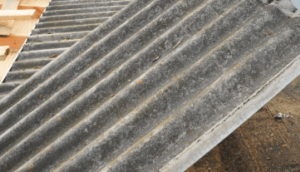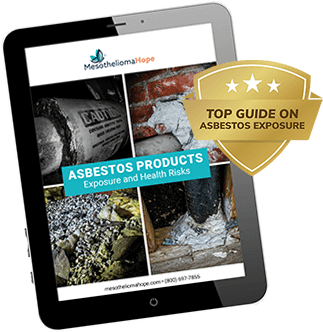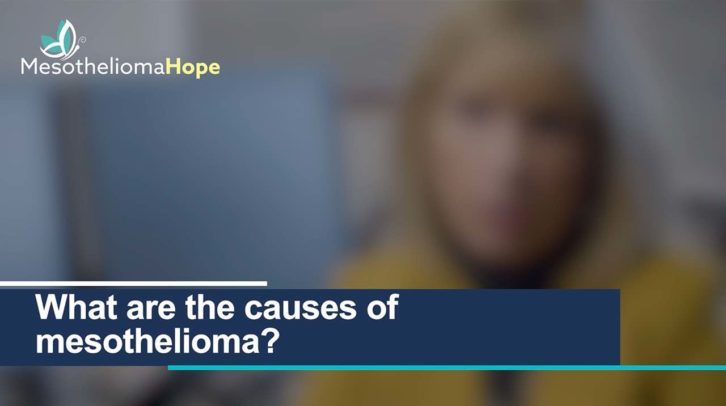What Is Asbestos?

Asbestos is a naturally occurring carcinogenic (cancer-causing) mineral that resists exposure to fire, sound, water, and chemicals. It is composed of millions of fibers that bind together to create a light yet virtually indestructible material.
Asbestos minerals are mined from natural deposits around the world. Once removed from the ground, they can be processed and developed into products.
Because of its properties and affordability, manufacturers used it to make thousands of products. As a result, dozens of industries — and countless jobs — relied on this substance.
Asbestos-containing products were used to construct:
- Buildings like offices and schools
- Planes and helicopters
- Naval ships
- Vehicles
- And more
Yet, the benefits of asbestos could not outweigh one major drawback: If a person inhales or swallows asbestos fibers, they can develop asbestos-related diseases like mesothelioma, a deadly and incurable cancer.
- About 27 million workers were exposed to asbestos from 1940-79.
- Asbestos exposure leads to about 250,000 deaths worldwide each year.
- Even a brief exposure to asbestos can result in an asbestos-related disease.
- Over 90% of asbestos-related deaths stem from workplace exposure.
- The U.S. has not banned asbestos even though more than 60 other countries have.
Download Mesothelioma Hope’s Free Asbestos Products Guide to see if you or someone you love may have been exposed to asbestos.
Types of Asbestos
Asbestos is often used as a blanket term. However, there are six different forms of asbestos.
The 6 types of asbestos are:
- Actinolite
- Amosite (also called cummingtonite-grunerite)
- Anthophyllite
- Chrysotile
- Crocidolite (also called riebeckite)
- Tremolite
Every type of asbestos can cause cancer, according to the U.S. Department of Health and Human Services.
The six types of asbestos belong to two main groups: amphibole asbestos and serpentine asbestos.
Amphibole Asbestos
Five of the six asbestos types fall under the category of amphibole asbestos.
Amphibole asbestos fibers are shaped like needles. Researchers have found that it takes less exposure to amphibole asbestos to cause cancer.
Serpentine Asbestos
Serpentine asbestos is the most common form of asbestos used industrially. Chrysotile asbestos is the only type that belongs to this group. It has curly and layered fibers.
As much as 95% of asbestos used in buildings in the U.S. is chrysotile asbestos, according to Penn Medicine’s Abramson Cancer Center.
Serpentine asbestos was used to make:
- Brake pads
- Cement
- Clutches
- Gaskets
- Roofing materials
- Tiles
Learn more about asbestos-containing products so you can keep your family safe — download your Free Asbestos Products Guide now.
Friable vs. Non-Friable Asbestos
Asbestos is also categorized by whether it is friable or non-friable.
Friable asbestos can be easily crumbled and poses an extreme danger to those nearby. Non-friable asbestos is sturdier and poses little risk unless it gets damaged or wears down.
“The potential for an asbestos-containing product to release breathable fibers depends largely on its degree of friability.”
The chart below shows the main differences between friable and non-friable asbestos.
| Friable Asbestos | Non-Friable Asbestos |
|---|---|
| Can be crumbled by hand, releasing fibers into the air | Sturdier and cannot be crushed by hand |
| Very dangerous to anyone nearby | Presents less of a risk to those nearby |
| Found in products including damaged asbestos cement, fireproofing, and spray-on ceiling treatments | Found in products including asphalt waterproof coating, cement sheets, and pipes |
Non-friable asbestos can become friable over time or when damaged.
If you believe you have friable asbestos-containing products in your home, consult an abatement (removal) professional immediately. Do not try to remove or dispose of it yourself. This could put you and your family at risk of asbestos exposure.
Where Is Asbestos Found?
Natural asbestos is found in rock deposits all over the world, including in the United States, China, Russia, and South America. Mining operations remove the mineral from the ground so it can be processed and used to make different products.
Asbestos mining was shut down in the U.S. in 2002, according to the Agency for Toxic Substances and Disease Registry (ATSDR). However, some asbestos continues to be imported into the country.
Further, the risk of asbestos is still prevalent today because the material can be found in products made before the mining ban.
For example, older homes, workplaces, schools, and other structures may still contain asbestos.
Asbestos-Related Diseases
Asbestos exposure can cause various illnesses, ranging from mild pleural plaques to deadly cancers like mesothelioma.
Learn about some of the most common diseases below.
Mesothelioma
Asbestos is the only known cause of malignant mesothelioma, a rare cancer that can form in the lining of the lungs, heart, abdomen, or testicles.
Registered Nurse Amy Fair discusses how exposure to asbestos can cause mesothelioma. View Transcript.
Duration: 1 min 06 sec
What are the causes of mesothelioma?
Many times after being diagnosed with mesothelioma your physician may ask you if you have been exposed to asbestos. Asbestos is a causative factor for mesothelioma. Some of the imaging studies may show underlying pleural plaques which are indicated that they have been around asbestos and may show underlying asbestosis.
The risk factors for developing mesothelioma are working around asbestos-related products or being indirectly around those products such as secondhand exposures that are seen with wives that launder their loved ones’ clothes and have asbestos dust on them. So direct asbestos exposure, as well as indirect asbestos exposure, can be causative factors for mesothelioma.
If you have symptoms of mesothelioma or any asbestos-related disease, it’s important that you inform your doctor of your asbestos exposure so that appropriate testing can be done.
Most cases of mesothelioma are not diagnosed until after the cancer has spread to other areas in the body, making it harder to treat.
How Asbestos Causes Mesothelioma
- Exposure: When asbestos products are disturbed, the fibers may be inhaled or ingested.
- Buildup: Then, the asbestos fibers can lodge themselves into the tissue linings of various organs.
- Damage: Once the fibers become stuck, they damage healthy tissue.
- Cancer: After 10-50 years of irritation, cancerous tumors can form.
Asbestosis
Asbestosis is a non-cancerous lung disease that causes lung scarring and breathing problems. This disease forms after asbestos fibers get trapped inside the lungs.
Over time, the lung gets progressively weaker and stiffer due to the damage caused by the asbestos fibers. This leads to painful symptoms such as a persistent cough, shortness of breath, and fatigue. Severe cases of asbestosis can be fatal.
Lung Cancer
Asbestos may cause lung cancer if the fibers get trapped in the lungs and cause the formation of malignant (cancerous) tumors.
Asbestos is the most significant cause of work-related lung cancer deaths in the world, according to a study published in a March 2022 issue of the International Journal of Environmental Research and Public Health.
Other Asbestos-Related Diseases
Additional asbestos-related illnesses include:
- Chronic obstructive pulmonary disease (COPD): This disease causes airflow blockage and breathing problems.
- Pleural effusions: These buildups of fluid within the pleura (lining of the lungs) can cause chest pain, coughing, and breathing issues.
- Pleural plaques: Asbestos fibers can damage the pleura and cause collagen (a protein) to build up. Over time, the collagen hardens and causes pleural thickening.
- Pleuritis: Also known as pleurisy, this condition occurs when the pleura becomes irritated. It causes chest pain and difficulty breathing.
It’s important to get examined by a specialist if you were exposed to asbestos and are now experiencing health problems.
You or a loved one may be owed some of this money — get help pursuing trust fund compensation today.
How Do You Get Exposed to Asbestos?
In general, people get exposed to asbestos by working with or near asbestos-containing products. When these products are installed, repaired, or otherwise manipulated, they can release microscopic fibers into the air. These fibers can be inhaled or swallowed by anyone in the area.
Blue-collar workers and military veterans are at a high risk for asbestos-related diseases as the mineral was heavily used by all military branches and on automotive, construction, and manufacturing work sites.
However, some people have been exposed in other ways. For example, they may have inhaled asbestos fibers contained in baby powder or other cosmetic products, or they may have come into contact with asbestos dust that people in their family brought home on their clothes.
Learn more about the products, jobs, and environments that put people at risk.
Asbestos-Containing Products
Companies made a wide variety of products using asbestos up until the early 1980s since the material was cheap, common, and useful in many applications.
About 3,000 different types of products contained asbestos, according to the New Jersey Department of Health.
The following products often contained asbestos:
- Adhesives
- Baby powder
- Boilers
- Brake pads
- Bricks
- Ceiling tiles
- Cement
- Drywall
- Floor tiles
- Gaskets
- Insulation
- Makeup
- Paint
- Pipes
- Plastics
- Pumps
- Roofing materials
- Shingles
- Talcum powder
- Valves
For a more complete list of asbestos-containing products, download your Free Asbestos Products Guide.
Asbestos in the Military
For more than 50 years, the U.S. military used asbestos-containing materials without knowing the deadly risks. The use of the mineral exploded during World War II and did not slow down until the early 1980s, exposing millions of service members.
Asbestos was considered the ideal military-grade material because it was an excellent fire retardant and insulator and resisted corrosion.
Asbestos was used in many military assets, including:
- Bases
- Housing
- Planes
- Ships
- Vehicles
While all branches of the military used asbestos-based products, no branch used it more than the U.S. Navy. The deadly mineral could be found throughout Navy ships and shipyards.
As a result, one-third of all mesothelioma cases can be traced back to Navy or shipyard asbestos exposure.
Today, many military veterans exposed to asbestos get diagnosed with deadly cancers like mesothelioma and other asbestos-related illnesses each year.
High-Risk Occupations


According to the National Cancer Institute (NCI), most people develop asbestos-related illnesses from being regularly exposed at work.
Numerous jobs put people in direct contact with asbestos before the health risks were widely known. Many were unprotected as they lacked protective gear and knowledge about the dangers of the material.
Learn about some of the riskiest asbestos-related occupations below.
Asbestos and Construction
Since it is so versatile, asbestos could be found in a wide range of materials used in the construction industry. From the 1930s to the early 1980s, many construction workers handled these products daily.
As asbestos products such as pipes and drywall were cut, drilled, and installed, fibers could become airborne. Workers who regularly breathed in the contaminated air were put at risk of getting sick decades later.


“I was exposed to asbestos through Sheetrock® products, the mud, through gaskets, in piping, through respirators. The cartridges and the filters had asbestos in them throughout my career.”
Some workers may even be at risk of asbestos exposure today. For example, demolishing an older building containing asbestos could send fibers into the air and endanger workers in the area.
Asbestos and Auto Mechanics
Manufacturers of car parts relied on asbestos to reduce heat and friction. However, as these parts were installed or repaired, they released toxic dust into the air. As a result, auto mechanics were put at risk of asbestos exposure every day.
Vehicle parts that may have contained asbestos included:
- Brake pads and shoes
- Clutches
- Electrical wires
- Hood liners
- Transmission parts


“We did a lot of grinding with sandpaper to prepare the brakes that we put in. We had asbestos dust everywhere, and we didn’t know any better.”
Asbestos and Firefighters
Fire can damage asbestos, causing the fibers to become airborne. Firefighters are at risk of inhaling these particles and developing asbestos-related diseases if older buildings constructed with the material catch on fire.
Additionally, the protective gear that firefighters have historically worn contained asbestos.
The International Association of Fire Fighters (IAFF) announced its support for a nationwide asbestos ban in August 2023.
“Firefighters are regularly exposed to airborne asbestos fibers as they respond to fires and other hazardous situations, making them 200 times more likely to develop related illnesses than the general public.”
Contact Mesothelioma Hope at (866) 608-8933 to see how we may be able to help you or a loved one who has gotten sick from asbestos exposure.
Secondary Asbestos Exposure
Workers and military service members often carried asbestos dust home on their clothing, hair, and skin. This put their loved ones in danger of secondhand exposure.
There are many stories of family members, particularly spouses and children, developing mesothelioma or other asbestos-related diseases due to secondhand or take-home exposure.
Wives were especially at risk as they typically handled and washed their husband’s asbestos-tainted work clothes.
Julie’s Story of Secondary Asbestos Exposure
Julie Gundlach’s father worked as an electrician for 40 years. She recalls running up and hugging him every day after he came home in his dust-covered work clothes. Julie was diagnosed with mesothelioma in 2006.


“When my mother washed my dad’s clothes in the laundry room that doubled as my playroom and shook out the dust, she had no idea she was spreading asbestos fibers throughout our house.”
What Companies Produced Asbestos-Containing Materials?
Many manufacturers have been using asbestos to make a wide variety of products since at least the late 1800s, according to a joint report from the NCI and the National Institutes of Health (NIH).
The companies listed below produced, sold, or distributed asbestos products:
- A&I Corporation
- A-Best Products
- AC&S
- API, Inc.
- A.P. Green Industries
- Armstrong World Industries
- ASARCO LLC
- Babcock and Wilcox Company
- Burns and Roe
- C. E. Thurston and Sons
- Combustion Engineering
- Congoleum Corporation
- DII Industries, LLC
- Eagle-Picher Industries
- EJ Bartells Company
- Federal-Mogul
- Flintkote Company
- H. K. Porter
- J. T. Thorpe
- Johns Manville
- Kaiser Aluminum
- Keene Corporation
- Lykes Brothers Steamship Co.
- MacArthur Company
- National Gypsum Company
- North American Refractories Company
- Plibrico Company
- Pittsburgh Corning Corporation
- Porter Hayden
- Quigley Company, Inc.
- Raytech Corporation
- Shook and Fletcher
- Skinner Engine Co.
- Stone and Webster
- Swan Transportation Company
- Synkoloid Company
- Thorpe Insulation Company
- United States Mineral Products Company
- UNR Industries
- Utex Industries, Inc.
- W.R. Grace
- Western Asbestos Company
After the deadly truth about asbestos gained national attention, these and many other manufacturers faced thousands of lawsuits from those who got sick from their products.
Some manufacturers declared bankruptcy and established asbestos trust funds to pay victims, while others are still dealing with lawsuits today.
If you got sick from asbestos-containing products made by manufacturers with trust funds, you may be able to receive payouts without going to court.
Some victims have been able to access asbestos trust fund compensation to help pay for their treatments. See if you or a loved one qualify for trust fund money.
What Asbestos Companies Didn’t Tell the Public
Asbestos was widely used because it was cheap and had many perceived benefits. The mineral also made product manufacturers wealthy.
Many manufacturers who used asbestos concealed the dangers because they wanted to keep making money.
Here’s some early evidence showing the health hazards of asbestos:
- In 1900, a London physician found asbestos fibers in the lungs of a textile worker who died from pulmonary fibrosis at age 33.
- In 1918, a U.S. Bureau of Labor Statistics report noted the early deaths of asbestos workers.
- In the 1930s, medical journals started publishing articles linking asbestos to different lung diseases.
- In 1935, the former president of brakes manufacturer Raybestos-Manhattan Inc. wrote in a letter to a lawyer that, “The less said about asbestos, the better off we are.”
From the 1930s on, many industry documents and internal corporate memos reveal that companies knew of the dangers of asbestos and its connection to various diseases.
Not only did these manufacturers suppress information about the health risks of asbestos, they opted not to make their products using safer materials.
For example, baby powder can be made out of cornstarch instead of talc (which may contain asbestos fibers). In addition, building materials like cement and paint no longer contain asbestos today.
Is Asbestos Still Used?
Unfortunately, yes. While the use of asbestos has been regulated in the United States, the deadly mineral has not been completely banned. As a result, manufacturers still make and sell asbestos-containing products today.
Additionally, asbestos is in many products and buildings made before the U.S. government heavily restricted how the mineral was used. Asbestos remaining in old buildings or products is known as legacy asbestos.
The bottom line is that people are still at risk of asbestos exposure today.
Is Asbestos Banned in the U.S.?
No. In 2022, more than 300 metric tons of chrysotile asbestos was imported into the U.S. This is a 300% jump in asbestos imports compared to 2021.
A chlorine manufacturer called OxyChem is the main importer of asbestos.
In April 2022, the U.S. Environmental Protection Agency (EPA) proposed banning almost all remaining asbestos uses. Most recently, in March 2023, the EPA released an updated proposal for a ban on all uses of chrysotile asbestos, the most common type and the one mainly used commercially.
If finalized, the EPA rule would go a long way toward providing workers and families with the protection they always deserved.
In the meantime, many advocates, policymakers, and political leaders continue to fight for increased awareness of the devastating health risks of asbestos.
Preventing Exposure to Asbestos Fibers
The only way to prevent exposure is to avoid asbestos-containing products. Sadly, while the use of asbestos has decreased, there are still many places where it can be found today.
For example, older structures like schools and offices may contain asbestos insulation materials, shingles, and tiling. These products are generally not dangerous unless they are damaged or disturbed. Older cars, mechanical equipment, and construction products may also contain asbestos.
If you believe a product in your home or workplace contains asbestos, you should leave it alone and talk to an asbestos removal expert.
How to Identify Asbestos Products
The U.S. Consumer Product and Safety Commission (CPSC) recommends looking for labels to see if a product contains asbestos. Unless the product is labeled, it is impossible to tell if it has asbestos.
If you can’t find a label, treat the product as if it contains asbestos and reach out to a professional who can take a sample and analyze it.
Download your Free Asbestos Products Guide to learn more about identifying asbestos-based products and keeping your family safe.
Removing and Phasing Out Asbestos
Today, professionals accredited by the EPA safely remove asbestos from older buildings if it threatens public health. This removal of asbestos-containing material is known as asbestos abatement.
Asbestos abatement programs were put in place as part of a larger plan to phase out the deadly mineral from use.
The U.S. military notably phased out asbestos-containing products throughout the 1980s. As a result, most — but not all — military assets are now free of asbestos.
Legal Options for Asbestos Exposure Victims
Those who have been diagnosed with mesothelioma and other asbestos-related diseases may be able to take legal action and pursue money to help cover treatment costs and other expenses.
Legal options for asbestos victims include:
- Mesothelioma lawsuits: Lawsuits against manufacturers of asbestos-containing products that cause mesothelioma usually settle out of court for more than $1 million.
- Asbestos trust fund claims: Bankrupt asbestos companies were forced to set aside money to compensate victims and their families. More than $30 billion is currently available in these trusts.
In many cases, people start receiving payouts from legal claims in less than 90 days.
Asbestos in the News: 2024 Updates
Even though asbestos has mostly been phased out in the U.S., it’s still making headlines.
Here are some 2024 asbestos-related updates:
- On January 12, 2024, the company Kelly-Moore Paints announced it was shutting down after paying out $600 million in asbestos lawsuits over the past 20 years.
- Former workers at Georgia-Pacific, a paper and building products manufacturer, are claiming the company is using controversial legal tactics to avoid paying millions of dollars in asbestos lawsuit compensation.
- On January 23, 2024, Johnson & Johnson reached a tentative agreement of around $700 million to settle legal claims in 42 states and Washington, D.C., related to asbestos contamination in its talc-based products.
Get Justice for Asbestos Exposure
If you or a loved one were exposed to asbestos and are now suffering from mesothelioma or another asbestos-related illness, you may qualify for financial compensation from the companies that caused you harm.
These companies knew of the dangers of asbestos yet did nothing to warn the public. For this reason, they should be held responsible for the damage they have inflicted.
Download your Free Asbestos Products Guide to see how you may have been exposed and learn about your legal options.
Asbestos Dangers FAQs
What does asbestos look like?
Generally speaking, asbestos is usually white with matted fibers that may crumble if they are old or damaged.
Asbestos-containing vermiculite insulation looks like shiny pebbles that are gold or brown, and asbestos wrap on pipes or boilers may look like a white cast.
If you believe that you have asbestos in the home, contact a licensed asbestos abatement company to have the material tested and removed if necessary.
What are the symptoms of asbestos exposure?
There are no symptoms of asbestos exposure. It’s not until 10-50 years after exposure that people start to notice symptoms of asbestos-related diseases.
These health effects include:
- Chest pain
- Persistent cough
- Shortness of breath
If you are experiencing any of these symptoms, it’s a good idea to see a doctor, especially if you worked around asbestos in the past. They can order tests such as a chest X-ray to make an accurate diagnosis.
When did they start using asbestos in houses?
Asbestos-containing products were used in the construction of houses from the 1930s until the early 1980s. These products include drywall, piping, roofing materials, and popcorn ceilings. The mineral could also be found in gas fireplaces, ovens, and many other household goods.
Today, asbestos material can still be found in about 30 million homes in the U.S., according to a 2019 PBS NewsHour report.
When did asbestos become toxic?
Asbestos is a carcinogenic (cancer-causing) mineral and has always been toxic.
The link between asbestos and cancer was first discovered in the 1930s. However, manufacturers continued to use the mineral to make thousands of products without warning the public of the health risks.
Is asbestos dangerous?
Yes, asbestos is dangerous. When inhaled, asbestos fibers can become lodged in the body and cause deadly diseases such as mesothelioma and lung cancer 10-50 years later.
While long-term exposure is most dangerous, even people with brief exposures have developed asbestos-related diseases.




